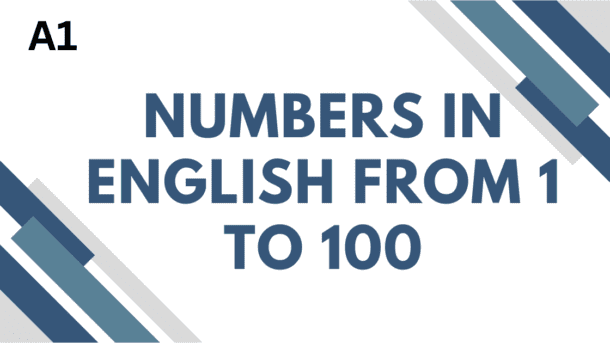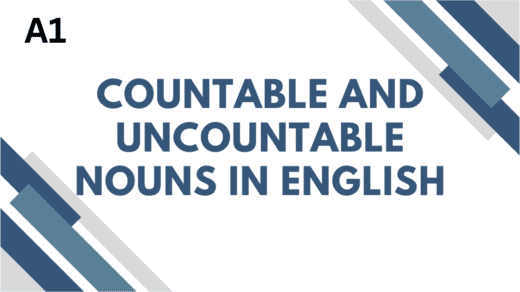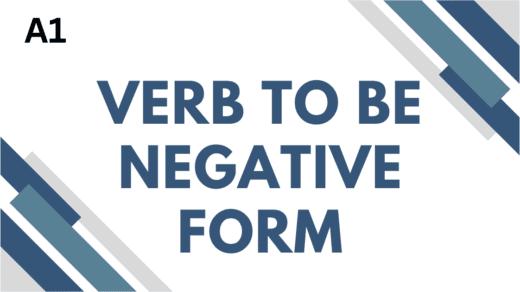By the end of this (Numbers in English) lesson, you will be able to count from 1 to 100 in English, recognize and spell the numbers correctly, and use them in simple contexts.
In this lesson, you will learn Numbers in English 0-100:
- Introduction to Numbers in English (1-10):
- Learn numbers: one, two, three, four, five, six, seven, eight, nine, ten.
- Practice counting aloud and writing each number.
- Tens (11-20):
- Learn teens: eleven, twelve, thirteen, fourteen, fifteen, sixteen, seventeen, eighteen, nineteen, twenty.
- Explain the pattern in teens and practice pronunciation and writing.
- Tens (21-50):
- Introduce the structure: twenty-one, twenty-two, …, twenty-nine, thirty.
- Emphasize the pattern of combining tens and units (e.g., twenty + one).
- Full Tens (51-100):
- Learn multiples of ten: thirty, forty, fifty, sixty, seventy, eighty, ninety, one hundred.
- Repeat the previous pattern for numbers like thirty-one, forty-five, etc.
Numbers in English from 0 to 10
- Zero (0)
- One (1)
- Two (2)
- Three (3)
- Four (4)
- Five (5)
- Six (6)
- Seven (7)
- Eight (8)
- Nine (9)
- Ten (10)
| Numeral | Spelling | Pronunciation |
|---|---|---|
| 0 | zero | ZEEUH-roh |
| 1 | one | wuhn |
| 2 | two | too |
| 3 | three | three |
| 4 | four | fawr |
| 5 | five | faiv |
| 6 | six | six |
| 7 | seven | SEH-vuhn |
| 8 | eight | ayt |
| 9 | nine | nain |
| 10 | ten | then |
Numbers in English: Counting from 11 to 20
Introduce the unique numbers from 11 to 20. Write them on the board and highlight their unique pronunciation and spelling.
- Eleven (11)
- Twelve (12)
- Thirteen (13)
- Fourteen (14)
- Fifteen (15)
- Sixteen (16)
- Seventeen (17)
- Eighteen (18)
- Nineteen (19)
- Twenty (20)
| Numeral | Spelling | Pronunciation |
|---|---|---|
| 11 | eleven | ee-LEHV-uhn |
| 12 | twelve | TWEL-vh |
| 13 | thirteen | THUHR-teen |
| 14 | fourteen | FAWR-teen |
| 15 | fifteen | FIF-teen |
| 16 | sixteen | SIX-teen |
| 17 | seventeen | SEH-vuhn-teen |
| 18 | eighteen | AY-teen |
| 19 | nineteen | NAIN-teen |
| 20 | twenty | TWEHN-tee |
Numbers in English: Counting from 21 to 50
As we count further, the numbers become more complex.
- Twenty-One (21): 20 + 1
- Twenty-Two (22): 20 + 2
- Twenty-Three (23): 20 + 3
- Twenty-Four (24): 20 + 4
- Twenty-Five (25): 20 + 5
- Twenty-Six (26): 20 + 6
- Twenty-Seven (27): 20 + 7
- Twenty-Eight (28): 20 + 8
- Twenty-Nine (29): 20 + 9
- Thirteen (30): 29+1
- Thirty-One(31): 30+1
- … and so on
| Numeral | Spelling | Pronunciation |
|---|---|---|
| 21 | twenty-one | TWEN-tee-WUHN |
| 22 | twenty-two | TWEN-tee-TOO |
| 23 | twenty-three | TWEN-tee-THREE |
| 24 | twenty-four | TWEN-tee-FAWR |
| 25 | twenty-five | TWEN-tee-FAIV |
| 26 | twenty-six | TWEN-tee-SIX |
| 27 | twenty-seven | TWEN-tee-SEH-vuhn |
| 28 | twenty-eight | TWEN-tee-AYT |
| 29 | twenty-nine | TWEN-tee-NAIN |
| 30 | thirty | THUHR-tee |
| 31 | thirty-one | THUHR-tee-WUHN |
| 32 | thirty-two | THUHR-tee-TOO |
| 33 | thirty-three | THUHR-tee-THREE |
| 34 | thirty-four | THUHR-tee-FAWR |
| 35 | thirty-five | THUHR-tee-FAIV |
| 36 | thirty-six | THUHR-tee-SIX |
| 37 | thirty-seven | THUHR-tee-SEH-vuhn |
| 38 | thirty-eight | THUHR-tee-AYT |
| 39 | thirty-nine | THUHR-tee-NAIN |
| 40 | forty | FAWR-tee |
| 41 | forty-one | FAWR-tee-WUHN |
| 42 | forty-two | FAWR-tee-TOO |
| 43 | forty-three | FAWR-tee-THREE |
| 44 | forty-four | FAWR-tee-FAWR |
| 45 | forty-five | FAWR-tee-FAIV |
| 46 | forty-six | FAWR-tee-SIX |
| 47 | forty-seven | FAWR-tee-SEH-vuhn |
| 48 | forty-eight | FAWR-tee-AYT |
| 49 | forty-nine | FAWR-tee-NAIN |
| 50 | fifty | FIF-tee |
Numbers in English: Counting from 51 to 100
- Twenty (20)
- Thirty (30)
- Forty (40)
- Fifty (50)
- Sixty (60)
- Seventy (70)
- Eighty (80)
- Ninety (90)
- One Hundred (100)
| Numeral | Spelling | Pronunciation |
|---|---|---|
| 51 | fifty-one | FIF -tee-WUHN |
| 52 | fifty-two | FIF-tee-TOO |
| 53 | fifty-three | FIF-tee-THREE |
| 54 | fifty-four | FIF-tee-FAWR |
| 55 | fifty-five | FIF-tee-FAIV |
| 56 | fifty-six | FIF-tee-SIX |
| 57 | fifty-seven | FIF-tee-SEH-vuhn |
| 58 | fifty-eight | FIF-tee-AYT |
| 59 | fifty-nine | FIF-tee-NAIN |
| 60 | sixty | SIX-tee |
| 61 | sixty-one | SIX-tee-WUHN |
| 62 | sixty-two | SIX-tee-TOO |
| 63 | sixty-three | SIX-tee-THREE |
| 64 | sixty-four | SIX-tee-FAWR |
| 65 | sixty-five | SIX-tee-FAIV |
| 66 | sixty-six | SIX-tee-SIX |
| 67 | sixty-seven | SIX-tee-SEH-vuhn |
| 68 | sixty-eight | SIX-tee-AYT |
| 69 | sixty-nine | SIX-tee-NAIN |
| 70 | seventy | SEH-vuhn-tee |
| 71 | seventy-one | SEH-vuhn-tee-WUHN |
| 72 | seventy-two | SEH-vuhn-tee-TOO |
| 73 | seventy-three | SEH-vuhn-tee-THREE |
| 74 | seventy-four | SEH-vuhn-tee-FAWR |
| 75 | seventy-five | SEH-vuhn-tee-FAIV |
| 76 | seventy-six | SEH-vuhn-tee-SIX |
| 77 | seventy-seven | SEH-vuhn-tee-SEH-vuhn |
| 78 | seventy-eight | SEH-vuhn-tee-AYT |
| 79 | seventy-nine | SEH-vuhn-tee-NAIN |
| 80 | eighty | AY-tee |
| 81 | eighty-one | AY-tee-WUHN |
| 82 | eighty-two | AY-tee-TOO |
| 83 | eighty-three | AY-tee-THREE |
| 84 | eighty-four | AY-tee-FAWR |
| 85 | eighty-five | AY-tee-FAIV |
| 86 | eighty-six | AY-tee-SIX |
| 87 | eighty-seven | AY-tee-SEH-vuhn |
| 88 | eighty-eight | AY-tee-AYT |
| 89 | eighty-nine | AY-tee-NAIN |
| 90 | ninety | NAIN-tee |
| 91 | ninety-one | NAIN-tee-WUHN |
| 92 | ninety-two | NAIN-tee-TOO |
| 93 | ninety-three | NAIN-tee-THREE |
| 94 | ninety-four | NAIN-tee-FAWR |
| 95 | ninety-five | NAIN-tee-FAIV |
| 96 | ninety-six | NAIN-tee-SIX |
| 97 | ninety-seven | NAIN-tee-SEH-vuhn |
| 98 | ninety-eight | NAIN-tee-AYT |
| 99 | ninety-nine | NAIN-tee-NAIN |
| 100 | one hundred | WUHN HUHN-druhd |
Tips for studying Numbers in English:
Studying numbers in English from 1 to 100 can be made easier and more effective with the following detailed tips:
- Visual Aids: Use charts, flashcards, or posters that display numbers 1-100. Visual representations help reinforce memory and make learning more engaging.
- Repetition: Regularly practice reciting the numbers aloud. Repetition solidifies memory; try counting daily, whether forward or backward.
- Group Numbers: Break the numbers into manageable groups, such as 1-10, 11-20, 21-30, etc. Focus on mastering one group before moving on to the next, which helps reduce overwhelm.
- Pattern Recognition: Identify patterns in numbers, especially in decades (20-29, 30-39). Recognizing patterns makes it easier to remember how numbers are formed, such as “twenty-one,” “twenty-two,” etc.
- Engaging Activities: Incorporate games like Bingo, matching games, or number scavenger hunts that involve finding or identifying numbers in different contexts.
- Incorporate Technology: Use apps and websites designed for language learning. Many digital tools provide interactive ways to practice spelling and pronouncing numbers.
- Practice Listening: Listen to songs, videos, or audio resources that emphasize numbers. Hearing numbers pronounced in context aids in improving listening skills and pronunciation.
- Write It Out: Practice writing numbers and their words. This reinforces spelling and helps retain the visual aspect of each number.
- Daily Use: Integrate numbers into daily conversations. For instance, ask for the time, count items around you, or refer to a calendar to strengthen real-life application.
- Assessment Quizzes: Regularly test your understanding through quizzes and self-assessments. This helps identify areas that may need more focus.




